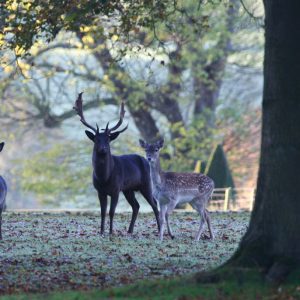Autumn at Lydiard Park
There is so much going on in autumn in nature. The trees put on a stunning display as their leaves turn red and yellow. Migrating birds such as the swallow will leave the UK for the warmer climate of Africa during September and will soon be followed by swifts and house martins. On the lakes, the swans and geese will be congregating; their cygnets and goslings will stay close by for the first year or two before setting out to find mates of their own.
 Speaking of mating, between late September and early November is the “rut” for fallow and roe deer. These abound in our local parks and fields. The rut is often triggered by shorter day lengths and will see the male deer bellow, (rut comes from the Latin for roar) rub their antlers against trees and indulge in a trial of strength with other bucks through clashing of antlers. If you are lucky enough to see a rut, the advice is to watch from a distance as deer can be very dangerous and aggressive when pumped up with testosterone.
Speaking of mating, between late September and early November is the “rut” for fallow and roe deer. These abound in our local parks and fields. The rut is often triggered by shorter day lengths and will see the male deer bellow, (rut comes from the Latin for roar) rub their antlers against trees and indulge in a trial of strength with other bucks through clashing of antlers. If you are lucky enough to see a rut, the advice is to watch from a distance as deer can be very dangerous and aggressive when pumped up with testosterone.
If you are out walking at dusk or in the night time you may well hear the tawny owls calling even more frequently and loudly than usual. All the hooting, shrieking, and “kee-wicking” is part of their territory-building. Young birds are looking to find their own homes whilst older birds are defending their patch.
Also very busy at this time of year are the squirrels. They disperse their food in many places to ensure that the entire year’s supply will not be lost if another animal finds a cache. Squirrels mark the nuts with their scent by rubbing them on their face or licking them. This procedure makes the nuts easier to locate later. And when burying, they dig a shallow pit, place the food in it, and cover it with debris. If you find little patches of ground that have been disturbed with digging, another animal may have found and stolen their acorns!